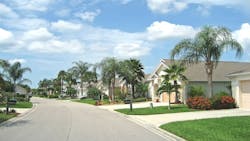Nationwide Home Prices Stagnate But Regional Variations Persist
The U.S. housing market is continuing to see prices moderate heading into the colder months, but not all markets are reporting the same level of stagnation. According to property data provider Cotality’s Home Price Insights Report, nationwide home prices grew by 1.2% from September 2024 to September 2025, and prices are expected to grow by another 4.1% through September 2026. However, the Northeast and Midwest are showing much stronger price growth, while Western and Southern metros are seeing minimal price increases.
For instance, Muskegon, Mich., saw prices grow by 14.1% year-over-year as of September. Similarly, Parkersburg, Pa., and Youngstown, Ohio, saw prices rise by 11% and 10.9% during this time. Meanwhile, many of the biggest price declines were in Florida, including Cape Coral, Naples, Punta Gorda, and Sebring. In these metros, prices declined by a respective 7.1%, 6.7%, 6.2%, and 5.2%.
Northeastern states are maintaining strong housing fundamentals, which has led to continued home price growth in the high single digits. However, western states like Alaska and Wyoming are showing a turnaround and posted home price growth this month. Both states had year-over-year gains above 5%. However, at the metro level, more areas are seeing depressed prices. In September, 20% of the 411 U.S. metropolitan areas saw annual price drops. This is the largest share of metros with declines in price growth since June 2023 when surging mortgage rates significantly cooled home prices.
“Much like the K-shaped trend seen in overall consumer spending—driven largely by higher income groups—lower-income potential homebuyers are facing challenges due to an uncertain job market, sluggish wage growth, and worsening financial conditions. This is leading to weaker demand for homes and downward pressure on prices,” said Cotality’s Chief Economist Dr. Selma Hepp.
Amid falling prices, there has been a rise in serious mortgage delinquencies in some states like Florida, a state where a large proportion of markets are experiencing ebbing prices. These lower prices reduce the amount of equity that homeowners can tap into even as escrow costs climb. People are paying an average of 45% more in escrow costs compared with five years ago, and that is pushing up monthly payments past the point of affordability. The increasing cost of owning a home has in part led to properties spending longer on the market and deals being more difficult to close despite for-sale inventory growing.
